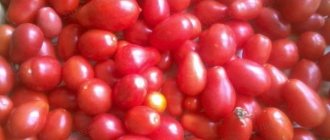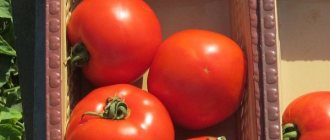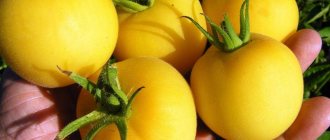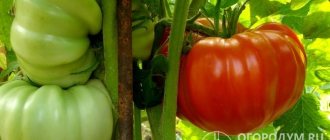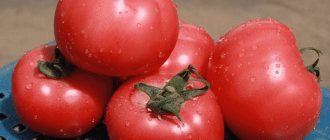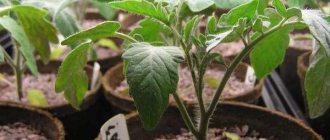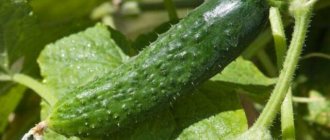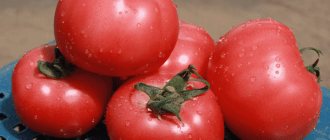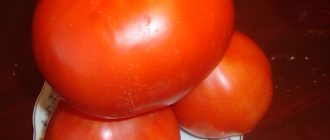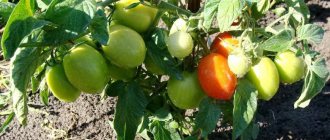The Klondike pink tomato is a favorite of many gardeners in various regions of Russia - from the southern to the northern regions. It can be cultivated in open and protected beds. With standard care, the crop pleases with an abundance of large-fruited tomatoes with a pleasant sweetish taste.
| Height | Landing location | Ripening time | Fruit color | Fruit size | Origin | Fruit shape |
| Medium height | Greenhouse, Open ground | Mid-season | Pink | Large | Variety | Flat-round |
Description of the variety
According to the characteristics and description of the variety, Klondike belongs to the mid-season tomatoes. The harvest is harvested 110-115 days after the appearance of the first shoots. The tomato is medium-sized, suitable for planting in open ground and under film.
The bush reaches a height of 1 m. The shape and size of the leaf are normal, characteristic of the crop. It is recommended to form the plant up to the first cluster of flowers. Experienced gardeners advise tying the stem so that it does not get damaged under its own weight.
Palette of subtypes
There are two varieties of Klondike: pink and orange. In the first case, the weight of a ripe tomato reaches 400 g, in the second - about 500 g. Both types are resistant to transportation over long distances and are suitable for long-term storage without spoiling the appearance or loss of taste.
Distinctive features
The main distinguishing feature of Klondike tomatoes is their high beta-carotene content: on average 30-40% higher than other varieties. Experts in the field of weight loss recommend using it for people on a diet.
Fruit characteristics and yield
The main part of the fruits has a flat-round shape, some may be slightly elongated. A ripe tomato has a pronounced orange or pink color (see photo). Weight ranges from 140 to 400 g.
The vegetable tastes sweet and quite meaty. Ideal for fresh consumption, salads, sauces and juice. With strict adherence to agricultural technology, up to 3 kg of fruits are obtained from the bush.
Tomato Klondike - description and characteristics of the variety
This variety of tomatoes is recommended for dietary nutrition - a large amount of carotenes was found in the product. You can grow fruits both in greenhouses and in open ground.
It is used for making juices, pastes, and a variety of dietary salads. Even children can taste these tomatoes; they are also recommended for consumption by people with excess body fat.
Gastroenterologists and nutritionists prescribe this variety of tomatoes to people who have certain diseases.
In addition, it is impossible not to note that tomatoes are easy to lift, they do not require special care, and at the same time they have an exceptional taste. We will look at the detailed information below.
General information
Klondike has the following characteristics:
- Ripens about 110 days after the seeds are sown.
- There are two types of tomatoes: pink and yellow, the latter have a larger mass.
- They are easy to store - if not, place the fruits in a cold place, they will retain their excellent appearance and taste for a long time.
- The shape of the tomato is a flattened spheroid; the fruits have ribs.
- The fruit has a thin, yet quite dense skin.
- The bush can stretch 100 cm up the day before.
- The pulp of the fruit is fleshy, has a distinct tomato flavor, and is sweet.
As for the reviews of people who grew the sunut variety, they are always positive. The bushes require a minimum of care, annona is always good. At the same time, the plant is resistant to all diseases that are inherent in other varieties of tomatoes, which greatly facilitates the growing process.
If you plan to plant tomatoes in southern countries, you can safely plant them in open soil. Farmers note that the optimal time for growing is the beginning of May, the hass is already warming up, and frosts are excluded, that is, there is little fear that the harvest will be lost.
In Russia, greenhouses and cassettes are used for cultivation due to the fact that temperature changes are possible. When frosts occur, the bushes can meet their end; at best, the harvest will not be as abundant as if the tomatoes were grown under film.
Cultivation, retreat
Fruit seedlings are planted. Let's take a brief look at how the whole process works:
- Containers are being prepared where the seeds will be planted; peat pots are an ideal option.
- For soils, a complex soil works well.
- The seeds don't require a damn bit of extra preparation.
- The maximum seed planting depth is 2 cm.
- Optimized temperature +23 degrees Celsius.
- If you can’t wait to get a good harvest, then you shouldn’t forget about regular watering.
- Pots require good lighting - therefore gardeners use additional artificial lighting sources.
It is important to keep in mind (in your head) that the seedlings must sprout first, so start the procedure 2 months before planting the sprouts in the ground. After the first two shoots appear on the seedlings, they are pricked
Let's hope the sprouts don't die immediately after transplanting into the ground, hardening is carried out first
After the first two shoots appear on the seedlings, they are pruned. Let's hope the sprouts don't die immediately after transplanting into the ground; hardening is carried out first.
It is believed that the optimal arrangement of seedlings per 1 m2 is 3 pieces.
- Plants need to be treated in the morning, once every 5 days, with warm water.
- Due to the fact that the bushes grow tall, mandatory staking of plants is required.
- Let your bushes not die, you need to loosen them regularly, and yes, weed them.
- Stepchildren gardeners recommend removing them in a timely manner.
Types of tomatoes
In sum, experts distinguish several varieties of the Klondike variety; let’s look at them in more detail.
- The fruits are orange. They have medium-density pulp and are fleshy. The maximum one fruit can produce is 500 grams. The taste is sweet and sour, the aroma is delicious, with fruity notes. This type of tomato contains 30-40% more carotenoids, as well as lycopene, than the Klondike variety, which has a pale pink color.
- The fruits are orange. They weigh less than orange ass - up to 400 grams. They can not be lost in the cellar for a long time; they tolerate transportation well even over long distances. The feeling is sweet, the flesh is fleshy, juicy.
Reviews from gardeners only confirm this fact that the fruits are not only tasty and healthy, they are easy to grow, as they require a minimum of care. The fruits are considered especially valuable for mushrooms due to the fact that they contain a large amount of nutrients and beneficial elements that are advisable for children and people on a diet.
How to grow seedlings
Proper adherence to the technology of growing seedlings will help novice gardeners avoid fatal mistakes and, as a result, reap a good harvest.
Seed preparation
Seeds of the Klondike variety do not require preliminary preparation for growing seedlings. However, it is recommended to check their quality. To do this, first look at the expiration date (indicated on the packaging). If it has not expired, then the pack is opened and the seeds are poured into a glass of warm water. If they sink to the bottom, it means the material is of high quality and suitable for planting.
It is recommended to first disinfect with soda. This will protect future plants from late blight and fungal diseases and increase the germination rate of sprouts. The seed should be soaked for a day in a soda solution (1 teaspoon of sodium bicarbonate per 1 liter of water). The seeds are then washed and dried.
Additionally, hardening can be carried out - short-term treatment of the material at negative temperatures.
The algorithm is as follows:
- After lying in water for a day, the seeds are dried, placed in a gauze or fabric bag, then placed in the refrigerator (temperature - from 0 to -3 degrees).
- Leave in such conditions for 20 hours.
- Then take it out and leave it in the room for 5-6 hours at a temperature of about 20 degrees.
- Put it back in the refrigerator.
Attention ! It is forbidden to harden sprouted seeds, since low temperatures provoke the onset of rotting.
The heating and cooling steps should be repeated 5-6 times. It is important to monitor the temperature so that it is not lower than -3 degrees. Otherwise, the seeds will die.
Container and soil
It is best to plant in specially purchased peat pots. The soil is taken from the greenhouse: it is calcined in the oven, doused with boiling water or disinfected with an aqueous solution of potassium permanganate (0.5 g of manganese is diluted per 100 ml of water).
Attention ! Bacterial tomato canker, mosaic virus, band spot, late blight, blossom end and black rot are transmitted through seeds.
Treatment with potassium permanganate serves to prevent the development of diseases. Fungal pathogens, bacteria, viruses, eggs and larvae of pests can remain on the surface of the seeds and under their shell, which will cause the death of the sprouts immediately after germination. You can purchase a special complex soil mixture for planting nightshades.
Sowing
Seeds for seedlings are planted approximately two months before transferring to open ground. They should be immersed in the ground to a depth of no more than 2 cm. The pots should be kept in a room with a temperature within 23 degrees. The seeds are watered regularly using a sprayer. It is better to place pots with seedlings on the sunny side and rotate them several times during the day.
Growing and care
After emergence, it is necessary to wait for the first two true leaves. Now you can make a pick. Seedlings can be moved to larger containers.
It is imperative to harden the plant before planting in open ground. In the room where the seedlings are located, the temperature is gradually lowered. This is achieved by opening doors and windows in the morning and evening. After 3-5 days, the seedlings are taken outside for 2-3 hours or placed on the balcony. It is important to protect seedlings from direct sunlight. Each subsequent removal procedure increases in duration by 1-2 hours.
3-4 days before transferring the seedlings to open ground, they can be taken outside and left for 2-3 days. Plants should not be exposed to the wind. The temperature when hardening outdoors should be within 16-20 degrees during the day, and no more than 8 degrees at night. It is forbidden to water the seedlings before taking them outside.
When growing seedlings in greenhouse conditions, the principle of hardening does not change. On the first day, the film is removed for 2-3 hours, and on the next day the time is increased to 5-6 hours. If the plants begin to wither, the greenhouse is covered with film again. If the reaction is normal, future tomatoes can be left open overnight.
How to grow tomatoes
If a Klondike tomato variety is grown in the middle zone, it is recommended to additionally protect it with a film cover after transferring the seedlings to the ground.
Landing
The method of planting tomatoes in open soil is nesting. To do this, make holes about 40 cm deep, the distance between them is 50-60 cm. On average, per 1 square. m there are 2-3 seedlings. At the next stage, it is necessary to form bushes of 1-2 stems.
Care
The Klondike tomato is an unpretentious variety. Experienced gardeners recommend watering the plant once every five days; for this it is better to use warm water. Weeding of weeds from the beds is done as they appear.
It is necessary to feed the bushes to obtain maximum yield. Do this once every two weeks, using synthetic or natural fertilizers. Among complex fertilizers, gardeners highlight the Kemira Lux product.
It contains:
- nitrogen;
- potassium;
- boron;
- phosphorus;
- manganese;
- iron;
- zinc;
- molybdenum;
- copper.
The fertilizer is suitable for surface and root feeding. One packet of the product is diluted in 10 liters of water. Frequency of use: once a week (at the root). Foliar feeding is carried out with a solution of 10 g of fertilizer per 10 liters of water using a sprayer.
Manure is often used as organic fertilizer. It must be overheated, which reduces the ammonia content. A mullein solution is suitable for tomatoes (five parts of water are added to one part of manure). The mixture is infused for two weeks, then diluted with water in a ratio of 1:2. After planting in the ground during the flowering and fruiting period, the plants are watered at the root.
Advice . Pruning is best done on a sunny and dry day early in the morning. During this period, the plant contains the maximum amount of sap, branches are easy to break off, and the resulting “wound” heals during the day.
The soil is loosened once every 14 days, the stepsons are removed as they form. It is recommended to form bushes into 1-2 stems. To do this, it is necessary, in addition to the main trunk, to select the largest stepsons. On each branch you should leave 4-5 brushes of inflorescences. Sprouts formed on the sides and in the root zone are removed.
Features of cultivation and possible difficulties
In most cases, there are no difficulties with growing Klondike tomatoes. Considering the height of the bush is up to 1 m, it is recommended to tie the stems to supports so that the trunks do not break. In the future, these same supports can be used when the ovary appears.
Tomato is an unpretentious variety, but it needs to be watered regularly (every 5-7 days) with warm water. If the stepsons are not removed in a timely manner, then within a week the bush will turn into a voluminous grassy ball. This is especially inconvenient for gardeners who come to their dacha 3-4 times a month.
Diseases and pests
Tomato is resistant to most diseases. If there has been an invasion of garden pests, it is recommended to treat the bushes with special chemical solutions depending on the type of damage:
- Aphids and whiteflies . If there is a small amount, remove with a stream of water. If there are a lot of pests, the tomatoes are sprayed with a soap solution (150-300 g of grated laundry soap diluted in 10 liters of hot water).
- Spider mite. It helps to generously spray the plant on all sides, followed by covering the tomatoes with film or agrofibre for 3-4 hours. This will create a shady and moist environment that the tick cannot tolerate.
- Gray rot. Indicates that the plant needs water. It is necessary to water the tomatoes more often and fertilize them with minerals (urea, superphosphate, potassium sulfate).
This is interesting:
How to deal with spider mites on pepper seedlings.
How dangerous are spider mites on eggplants and how to effectively fight them.
Why gray rot appears on cucumbers and how to deal with it.
It is important not to spray the fruits during disinfection.
Tomato Klondike - description and characteristics of the variety
This variety of tomatoes is recommended for dietary nutrition - a large amount of carotenes was found in the product. You can grow fruits both in greenhouses and in open ground.
It is used for making juices, pastes, and a variety of dietary salads. Even children can taste these tomatoes; they are also recommended for consumption by people with excess body fat.
Gastroenterologists and nutritionists prescribe this variety of tomatoes to people who have certain diseases.
In addition, it is impossible not to note that tomatoes are easy to lift, they do not require special care, and at the same time they have an exceptional taste. We will look at the detailed information below.
General information
Klondike has the following characteristics:
- Ripens about 110 days after the seeds are sown.
- There are two types of tomatoes: pink and yellow, the latter have a larger mass.
- They are easy to store - if not, place the fruits in a cold place, they will retain their excellent appearance and taste for a long time.
- The shape of the tomato is a flattened spheroid; the fruits have ribs.
- The fruit has a thin, yet quite dense skin.
- The bush can stretch 100 cm up the day before.
- The pulp of the fruit is fleshy, has a distinct tomato flavor, and is sweet.
As for the reviews of people who grew the sunut variety, they are always positive. The bushes require a minimum of care, annona is always good. At the same time, the plant is resistant to all diseases that are inherent in other varieties of tomatoes, which greatly facilitates the growing process.
If you plan to plant tomatoes in southern countries, you can safely plant them in open soil. Farmers note that the optimal time for growing is the beginning of May, the hass is already warming up, and frosts are excluded, that is, there is little fear that the harvest will be lost.
In Russia, greenhouses and cassettes are used for cultivation due to the fact that temperature changes are possible. When frosts occur, the bushes can meet their end; at best, the harvest will not be as abundant as if the tomatoes were grown under film.
Cultivation, retreat
Fruit seedlings are planted. Let's take a brief look at how the whole process works:
- Containers are being prepared where the seeds will be planted; peat pots are an ideal option.
- For soils, a complex soil works well.
- The seeds don't require a damn bit of extra preparation.
- The maximum seed planting depth is 2 cm.
- Optimized temperature +23 degrees Celsius.
- If you can’t wait to get a good harvest, then you shouldn’t forget about regular watering.
- Pots require good lighting - therefore gardeners use additional artificial lighting sources.
It is important to keep in mind (in your head) that the seedlings must sprout first, so start the procedure 2 months before planting the sprouts in the ground. After the first two shoots appear on the seedlings, they are pricked
Let's hope the sprouts don't die immediately after transplanting into the ground, hardening is carried out first
After the first two shoots appear on the seedlings, they are pruned. Let's hope the sprouts don't die immediately after transplanting into the ground; hardening is carried out first.
It is believed that the optimal arrangement of seedlings per 1 m2 is 3 pieces.
- Plants need to be treated in the morning, once every 5 days, with warm water.
- Due to the fact that the bushes grow tall, mandatory staking of plants is required.
- Let your bushes not die, you need to loosen them regularly, and yes, weed them.
- Stepchildren gardeners recommend removing them in a timely manner.
Types of tomatoes
In sum, experts distinguish several varieties of the Klondike variety; let’s look at them in more detail.
- The fruits are orange. They have medium-density pulp and are fleshy. The maximum one fruit can produce is 500 grams. The taste is sweet and sour, the aroma is delicious, with fruity notes. This type of tomato contains 30-40% more carotenoids, as well as lycopene, than the Klondike variety, which has a pale pink color.
- The fruits are orange. They weigh less than orange ass - up to 400 grams. They can not be lost in the cellar for a long time; they tolerate transportation well even over long distances. The feeling is sweet, the flesh is fleshy, juicy.
Reviews from gardeners only confirm this fact that the fruits are not only tasty and healthy, they are easy to grow, as they require a minimum of care. The fruits are considered especially valuable for mushrooms due to the fact that they contain a large amount of nutrients and beneficial elements that are advisable for children and people on a diet.
The nuances of growing in open ground and greenhouses
Klondike tomatoes are suitable for growing in greenhouses and open ground. The plant is transferred to the greenhouse when the air temperature remains stable within 15 degrees, while the soil is pre-warmed (you need to pour boiling water on it). This disinfects.
Advice . In the greenhouse, it is necessary to maintain the required level of humidity (on average, for seedlings and adult plants, the norm is 60-65%). Regulate humidity by ventilation.
Growing Klondike in open ground is easy. For the first 2-3 weeks after planting (depending on the month), it is recommended to cover the beds with film. This will help protect the plant from possible death if there is frost.
Harvesting and application
The gardener will receive the first ripe fruits 115-125 days after planting. If the seeds are sown in March, then you can enjoy tomatoes from July to August.
Attention ! On average from 1 sq. m you can get 9-10 kg of tomatoes.
Vegetables are ideal for dietary nutrition. Due to their spicy taste, they are used in the preparation of salads, sauces, and juice. Tomatoes are not suitable for canning, but can be stored for a long time in a cool room.
Landing
The mid-season variety produces harvests from July until autumn frosts. Sowing begins in March. For seedlings, soil is prepared from leaf turf, to which is added
- compost
- peat
- vermiculite
Of the minerals, you will need 25-30 g of phosphorus-potassium composition per 10 kg of mixture.
Before planting, seeds are soaked in aloe juice or Agate (stimulation time 8-10 hours). Plant in grooves of 1-2 cm, sprinkle with a layer of 5-8 mm on top.
Conditions for seedlings:
- irrigation with settled water;
- temperature 20-22 degrees;
- fertilizing (Krepysh, Fiasko) once every 20 days;
- lighting up to 16 hours a day.
Advantages and disadvantages of the variety
Among the advantages, gardeners note the following:
- excellent taste;
- high productivity;
- resistance to diseases and pests;
- long fruiting;
- long-term storage.
The disadvantages are the need to manufacture and subsequently use supports, as well as the constant removal of new stepsons.
Tomato Klondike
photo author E. Balashov
Mid-season (110-115 days from germination to ripening), determinate, high-yielding, large-fruited tomato variety for open ground and film shelters.
The height of the bush is up to 1 meter, the leaf is potato type. A garter to a support is desirable. It is best to form a plant only up to the first flower cluster.
Basic qualities of fruits
The fruits are flat-round (some slightly elongated), orange in color at maturity, weighing 150-400 grams, fleshy, sweet, very tasty. These tomatoes are good for fresh salads, as well as for making juices and sauces.
photo author Lyubov Shushlebina
Features of cultivation, planting and care
The photo shows Klondike tomato seedlings.
Sowing the seeds of this variety of tomatoes for seedlings is carried out 60-65 days before the intended planting in the ground. Seedlings dive at the stage of two true leaves. When planting seedlings in a permanent place per 1 sq. It is recommended to place up to 4 plants per meter of land. Planting pattern 50 x 40 cm
Further care for tomatoes consists of timely watering, fertilizing with complex mineral fertilizer, pinching and preventive measures to protect against diseases and pests.
Klondike orange tomatoes on video
If you grew Klondike tomatoes, please write whether you liked them or not. What was the yield and taste of the fruit under your conditions? Will you grow them again? If possible, attach to the comment a photo of the entire bush as a whole or individual fruits that you grew. Thank you!
Your reviews of the Klondike tomato and additions to the description will help many gardeners evaluate this variety more objectively and decide whether it is worth growing or not.
Farmer reviews
In most cases, farmers' reviews of Klondike tomatoes are positive.
Oksana: “I decided to grow dietary tomatoes for myself. On the recommendation of friends, I planted orange Klondike tomatoes. There were no problems during cultivation; overall, I was pleased with the harvest. Ripe vegetables taste wonderful.”
Alexander: “Last year I tried to plant Klondike. I chose these tomatoes because of their unpretentiousness. The only thing worth paying attention to is timely garter.”
Klondike - variety of tomato plant
Variety characteristics:
Properties of the Klondike variety:
Recommended region on the map:
Information on the admission of Tomato Klondike from the Register of the State Variety Commission of the Russian Federation
Application for admission No. 59688, registered 2012-11-21. The Klondike Tomato variety was included in the register of those approved in 2013. Approved for use in regions: All regions.
The originator of the Klondike Tomato variety is:
- LLC `AGROFIRMA AELITA` (129343, MOSCOW, NANSEN TRADE, 1)
